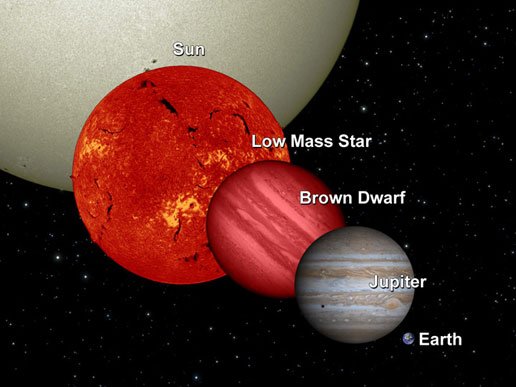SIMP0136: Star Dwarf Chocolate mass of the planet

A brown dwarf is an object smaller than a star, but larger than a giant planet. Their size is not large enough to maintain a fusion reaction in the energy-generating nucleus. As a result, they can not shine and retain heat for a long time. Moments after forming, brown dwarfs will cool and contract (shrink) slowly. This contraction usually ends after several hundred million years while the cooling takes place on an ongoing basis.
Some time ago, a team consisting of Jonathan Gagné of Carnegie Institution for Science and several other researchers from the Institute for Research on Exoplanets (iREx) at the Université de Montréal, the American Museum of Natural History and the University of California San Diego found that dwarfs the nearest chocolate from our Sun turns out to be a mass planetary object. The team found that a brown dwarf named SIMP J013656.5 + 093347, or simply called SIMP0136, is a planet-like object that is a member of the Carina-Near (Carina-Near moving group) cluster. The star cluster is already 200 million years old. The star cluster is a collection of stars that have similar ages and move together in space. Observations of star clusters can be used to measure the age, temperature, and mass of each member.
Gagné and his team found that SIMP0136 has a mass 13 times larger than the mass of Jupiter, right on the border of the mass that separates the brown dwarf and the planet. Therefore, SIMP0136 is classified as a brown dwarf that has a planet-like mass. Unlike planets, brown dwarfs in their early stages had reacted deuterium (a hydrogen isotope composed of 1 electron, 1 proton, and 1 neutron with a D or 2H symbol) at its center to produce energy, although it did not last long.
Why is SIMP0136 discovery important? Currently, astronomers are vociferously studying the atmosphere of giant planets, both within and outside the Solar System. The giant exoplanet's atmosphere is harder to learn because the light of the exoplanet is much lighter than its parent starlight. As a result, the instruments used will be "blinded" by the glare of the starlight. The planet's free-floating object such as SIMP0136 is an important object because its characteristic is similar to a gigantic gas exoplanet orbiting its parent star and its atmosphere is relatively easier to learn. By studying the atmosphere of SIMP0136, it is hoped that we can understand the physical processes and evolution of the giant planet's atmosphere in general.
Reference :
- https://xissufotoday.space/2017/05/brown-dwarf-is-actually-a-planetary-mass-object/
- https://www.sciencedaily.com/releases/2017/05/170509122026.htm
- https://www.astrobio.net/also-in-news/surprise-brown-dwarf-actually-planetary-mass-object/
- http://www.visiontimes.com/2017/05/15/oops-researchers-discover-brown-dwarfs-are-planetary-mass-objects.html
I need to know if it’s possible to live on dwarfs stars if we terra form it to fit our own needs. Or we could place large dome structures on dwarf stars and start colonies like those.
This post has received a 1.50 % upvote from @booster thanks to: @alf4t1h.
Congratulations! This post has been upvoted from the communal account, @minnowsupport, by alf4t1h from the Minnow Support Project. It's a witness project run by aggroed, ausbitbank, teamsteem, theprophet0, someguy123, neoxian, followbtcnews, and netuoso. The goal is to help Steemit grow by supporting Minnows. Please find us at the Peace, Abundance, and Liberty Network (PALnet) Discord Channel. It's a completely public and open space to all members of the Steemit community who voluntarily choose to be there.
If you would like to delegate to the Minnow Support Project you can do so by clicking on the following links: 50SP, 100SP, 250SP, 500SP, 1000SP, 5000SP.
Be sure to leave at least 50SP undelegated on your account.